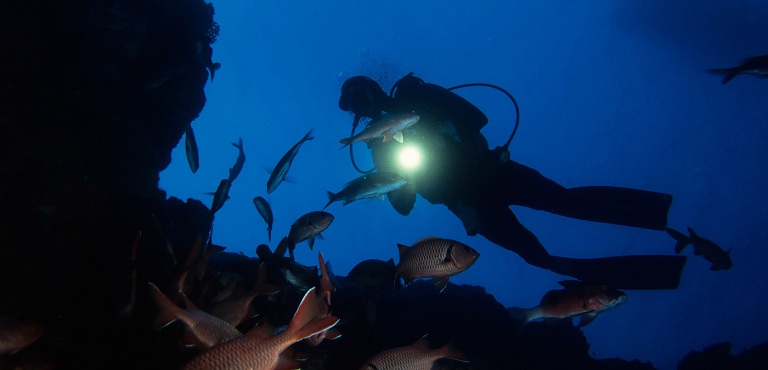Australia’s underwater world is truly breathtaking. We’ve all seen the brilliant exotic colours of the Great Barrier Reef on Discovery Channel specials and magazine features. But if you were to dive in right this instant, without any gear and somehow survive, what you will be greeted by is a depressing bluish-grey void. This is because as you dive deeper water rapidly absorbs the colours in the red part of the spectrum, leaving only the blue palette behind. And that’s the answer if you were wondering why the ocean is blue.
However, a powerful diving torch can give a diver a proper glimpse of the colourful and spectacular life hiding beneath the sea surface. Not to mention how proper illumination will make you feel safer in such a vast space where anything can swim up behind you. As diving gear evolved to perfection, so did diving torches. Now a modern diver is faced with the dilemma what to pick out of the hundreds of different diving torches for sale. To make it easier for you, we’ve reduced the process to the 3 most important consideration steps. Let’s dive in now!
The Main Purpose
Different torches are designed with different purposes in mind. For stunning aquatic snaps, you should be looking for a diving and photography torch with red and UV light. The red and ultraviolet lights bring out the invisible red part of the spectrum and allow you to capture the beautiful bio-luminescence of sea creatures. You might also want to consider a torch that emits at a 110° for a wider beam if you want to do some scenery photography.
A wide beam torch is also good if you plan to use it at night and for moving through broad seascapes. A lumen rating of 3000 and above is essential for night dives, caves and over-all badly lit surroundings. But if you’re planning to spend time mostly near the surface and during the day, a narrow handheld beam is handy and light to carry. You can even store it on your BCD when you’re not using it.
On the top of the evolution scale of diving torches lie technical lights. Technical, or also called search lights, feature a penetrating beam of 4000+ lumens that reaches a distance up to 300 metres. Impact resistant and with a very long battery life, these diving torches are the most reliable for any fearless professional diver that does cave or shipwreck exploring.
The Bulb Technology
I’m going to cut to the chase and tell you upfront that LED is without a doubt the best technology for diving torches. With a ruining life of 50 000 hours which considerably eclipses that of other “bulb” types, no surprise it’s the go to choice for 99% of divers. LED also boasts with amazing energy-efficiency, meaning it doesn’t wear out the batteries and thus prolongs the time you can remain submerged.
It’s also important to note that greater bulb efficiency also allows for higher lumen output. Even the most powerful torches with 5000+ lumens can’t completely reach their full potential if they aren’t LED. However, it is rare that you’ll come across diving torches for sale that aren’t LED. The advances in LED technology have led to an almost complete wipe out of Halogen/Xenon bulbs, with most manufacturers no longer selling them.
The Battery
There are three basic types of batteries f0or diving torches, and each of them has its own advantages and disadvantages. This is not a clear cut decision like the bulb technology was, so it’s all up to your personal preferences.
The good old alkaline batteries (AAA, C) are the most inexpensive and are available globally. A torch powered by alkaline batteries is convenient when you’re making frequent dives to different areas around the world. However, their main disadvantage is the low performance level and reduced battery life when used with a powerful lumen output.
When it comes to performance, CR123 lithium batteries are unparalleled and can withstand incredibly high lumen levels. Their drawbacks are that they are a more expensive option and difficult to get in remote diving locations. CR123 lithium batteries are also forbidden when travelling by plane in some parts of Europe.
For those who dive frequently, internal rechargeable batteries are typically the best choice. Eliminating the need to frequently toss out and change batteries, they are pocket-friendly as much as they are eco-friendly. However, they require access to power which nowadays can be easy to take with you even on a boat in the form of a cheap portable power bank.

